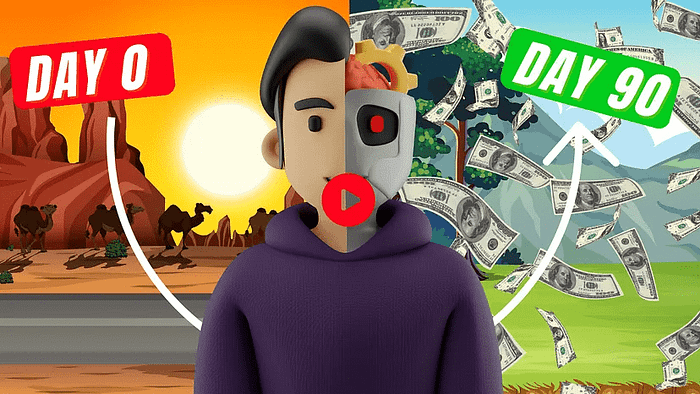How GPT Prompts Can Revolutionize Your Content Creation Process
Picture this: You’re staring at a blank screen, cursor blinking, waiting for inspiration to strike. Suddenly, GPT prompts come to your rescue, igniting a spark of creativity and transforming your content creation journey.
GPT prompts are not just a tool; they’re your secret weapon in the battle against writer’s block and mediocre content.
These powerful AI-driven aids can help you craft compelling stories, generate innovative ideas, and produce high-quality content at an unprecedented pace.
But how exactly do GPT prompts work their magic? And more importantly, how can you harness their potential to revolutionize your content creation process?
In this comprehensive guide, we’ll explore the ins and outs of GPT prompts, their impact on content creation, and practical strategies to integrate them into your workflow.
Get ready to discover how GPT prompts can take your content game to the next level, boosting your productivity and unleashing your creative potential like never before.
We strongly recommend that you check out our guide on how to take advantage of AI in today’s passive income economy.
Table of Contents
Understanding GPT Prompts: The Building Blocks of AI-Assisted Content Creation
Before we dive into the transformative power of GPT prompts, let’s take a moment to understand what they are and how they function.
GPT prompts are essentially instructions or queries given to an AI language model, guiding it to generate specific types of content or responses.
These prompts serve as the foundation for AI-assisted content creation, acting as a bridge between human creativity and machine intelligence.
When you provide a GPT prompt, you’re essentially giving the AI a starting point or context from which to generate text.
The beauty of GPT prompts lies in their versatility and adaptability. They can be as simple as a single word or as complex as a detailed paragraph, depending on your needs and the desired output.
The Science Behind GPT Prompts
At the heart of GPT prompts is the GPT (Generative Pre-trained Transformer) technology, a sophisticated neural network trained on vast amounts of text data.
This AI model uses statistical patterns and contextual understanding to generate human-like text based on the input it receives.
When you craft a GPT prompt, you’re essentially tapping into this vast network of knowledge and language patterns.
The AI analyzes your prompt, draws upon its training data, and generates text that aligns with the given context and instructions.
It’s like having a highly knowledgeable and creative assistant at your fingertips, ready to help you brainstorm, draft, and refine your content.
The Evolution of GPT Prompts
GPT prompts have come a long way since their inception. Early versions were relatively simple and often produced inconsistent results.
However, with advancements in AI technology and machine learning algorithms, modern GPT prompts have become increasingly sophisticated and reliable.
Today’s GPT prompts can understand nuanced instructions, adapt to different writing styles, and even mimic specific tones or voices.
This evolution has opened up new possibilities for content creators, allowing them to leverage AI in ways that were previously unimaginable.
Revolutionizing Content Creation: The Impact of GPT Prompts
Now that we have a solid understanding of what GPT prompts are, let’s explore how they’re revolutionizing the content creation process.
GPT prompts are not just a fancy tech gimmick; they’re a game-changer for writers, marketers, and content creators across various industries.
By harnessing the power of GPT prompts, you can overcome common content creation challenges and unlock new levels of productivity and creativity.
Breaking Through Writer’s Block
One of the most significant ways GPT prompts revolutionize content creation is by helping writers overcome the dreaded writer’s block.
We’ve all been there – staring at a blank page, struggling to find the right words or ideas to get started.
GPT prompts act as a catalyst, providing that initial spark needed to kickstart your creative process.
By inputting a simple prompt related to your topic, you can generate a wealth of ideas, opening up new avenues for exploration and inspiration.
This doesn’t mean the AI will write your content for you, but it can certainly help you break through mental barriers and get your creative juices flowing.
Enhancing Productivity and Efficiency
In today’s fast-paced content landscape, productivity is key. GPT prompts can significantly boost your efficiency by streamlining various aspects of the content creation process.
From generating outlines and drafting introductions to expanding on key points, GPT prompts can help you move through your content creation tasks more quickly.
This increased efficiency doesn’t just save time; it also allows you to produce more content without sacrificing quality.
Imagine being able to create multiple blog posts, social media updates, or marketing copy in a fraction of the time it usually takes.
That’s the kind of productivity boost GPT prompts can offer when used effectively.
Fostering Creativity and Innovation
Contrary to the fear that AI might stifle human creativity, GPT prompts actually have the potential to enhance and amplify your creative abilities.
By providing unexpected angles, unique perspectives, and novel ideas, GPT prompts can push you out of your creative comfort zone.
They can help you explore new topics, experiment with different writing styles, and discover innovative approaches to content creation.
This synergy between human creativity and AI assistance can lead to truly remarkable and original content that stands out in a crowded digital landscape.
Improving Content Quality and Consistency
When used thoughtfully, GPT prompts can contribute to improving the overall quality and consistency of your content.
By providing a structured framework for your ideas, GPT prompts can help ensure that your content is well-organized, coherent, and on-topic.
They can also assist in maintaining a consistent tone and style across different pieces of content, which is particularly valuable for brands aiming to establish a strong, recognizable voice.
Moreover, GPT prompts can help you generate more comprehensive and in-depth content by suggesting additional points, examples, or perspectives you might not have considered otherwise.
Practical Strategies for Integrating GPT Prompts into Your Content Creation Workflow
Now that we’ve explored the transformative potential of GPT prompts, let’s dive into some practical strategies for integrating them into your content creation workflow.
Remember, GPT prompts are a tool to enhance your creativity, not replace it. The key is to find the right balance between AI assistance and your unique human touch.
Crafting Effective GPT Prompts
The effectiveness of GPT prompts largely depends on how well you craft them. Here are some tips for creating prompts that yield the best results:
- Be specific and clear in your instructions. The more detailed your prompt, the more tailored the output will be.
- Experiment with different prompt structures. Try using questions, statements, or even role-playing scenarios to guide the AI.
- Include key information like tone, style, target audience, and any specific requirements in your prompt.
- Use examples or templates to guide the AI towards the desired format or structure.
- Don’t be afraid to iterate. If the first output isn’t quite what you’re looking for, refine your prompt and try again.
Leveraging GPT Prompts for Ideation and Brainstorming
One of the most powerful ways to use GPT prompts is for idea generation and brainstorming. Here’s how you can leverage them effectively:
- Start with broad prompts to generate a wide range of ideas, then narrow down to more specific topics.
- Use GPT prompts to explore different angles or perspectives on a topic you’re writing about.
- Generate lists of potential blog post titles, article outlines, or content themes using targeted prompts.
- Combine GPT-generated ideas with your own insights to create unique and compelling content concepts.
- Use prompts to brainstorm creative solutions to content-related challenges or to explore new content formats.
Using GPT Prompts for Content Structure and Outlines
GPT prompts can be incredibly useful for creating structured content outlines. Here’s how to make the most of this feature:
- Input your main topic and ask the AI to generate a basic outline or table of contents.
- Use prompts to expand on each section of your outline, generating subtopics and key points.
- Ask for specific types of content within your outline, such as examples, statistics, or case studies.
- Use GPT prompts to suggest transitions between different sections of your content.
- Experiment with different organizational structures by asking the AI to reorder or reorganize your outline.
Enhancing Your Writing with GPT Prompts
While GPT prompts shouldn’t replace your writing, they can certainly enhance it. Here are some ways to use prompts to improve your content:
- Use GPT prompts to generate compelling introductions or conclusions for your articles.
- Ask for suggestions on how to make your writing more engaging or persuasive.
- Use prompts to help you explain complex concepts in simpler terms.
- Generate metaphors, analogies, or examples to illustrate your points more effectively.
- Use GPT prompts to help you vary your sentence structure and vocabulary for more dynamic writing.
Overcoming Challenges and Limitations of GPT Prompts
While GPT prompts are powerful, they’re not without limitations. Here’s how to navigate some common challenges:
- Always fact-check AI-generated information, as GPT models can sometimes produce inaccurate or outdated content.
- Be mindful of potential biases in AI-generated content and strive to maintain diversity and inclusivity in your writing.
- Use GPT prompts as a starting point, but always add your unique voice and expertise to the content.
- Be aware of copyright issues. While GPT models are trained on public data, it’s important to ensure your final content is original.
- Don’t rely too heavily on GPT prompts. Balance AI assistance with your own critical thinking and creativity.
The Future of Content Creation: Embracing the GPT Prompt Revolution
As we look to the future, it’s clear that GPT prompts and AI-assisted content creation are here to stay.
The technology behind GPT prompts is rapidly evolving, promising even more sophisticated and tailored content assistance in the years to come.
This doesn’t mean that human creativity will become obsolete. On the contrary, the role of content creators will likely shift towards becoming skilled prompt engineers and AI collaborators.
Emerging Trends in GPT Prompt Technology
Several exciting trends are shaping the future of GPT prompts and content creation:
- Increased personalization: Future GPT models may be able to learn and adapt to individual writing styles and preferences.
- Multi-modal prompts: We may see the integration of text, images, and even audio in crafting more complex and nuanced prompts.
- Industry-specific models: GPT prompts tailored to specific industries or niches could provide more targeted and relevant content assistance.
- Enhanced ethical AI: Future developments will likely focus on addressing issues of bias, ensuring more balanced and inclusive content generation.
- Interactive prompting: We might see more dynamic, conversation-like interactions with AI for content creation, allowing for real-time refinement and collaboration.
Preparing for the Future of AI-Assisted Content Creation
To stay ahead in this evolving landscape, content creators should:
- Continuously educate themselves about AI and GPT technology to understand its capabilities and limitations.
- Develop strong prompt engineering skills to make the most of AI-assisted content creation tools.
- Focus on developing uniquely human skills like creativity, critical thinking, and emotional intelligence.
- Stay adaptable and open to integrating new AI tools and techniques into their content creation process.
- Maintain a strong ethical compass and prioritize creating valuable, authentic content for their audience.
In conclusion, GPT prompts are revolutionizing the content creation process in ways we’re only beginning to fully grasp.
By understanding how to effectively leverage GPT prompts, content creators can unlock new levels of productivity, creativity, and innovation.
The key lies in finding the right balance between AI assistance and human expertise, using GPT prompts as a powerful tool to enhance, not replace, your unique creative voice.
As we move forward, those who can skillfully navigate this new landscape of AI-assisted content creation will be well-positioned to thrive in the ever-evolving digital world.
So, are you ready to embrace the GPT prompt revolution and transform your content creation process?
The future of content is here, and it’s more exciting than ever before.
Frequently Asked Questions:
What are some good ChatGPT prompts?
Good ChatGPT prompts are clear, specific, and tailored to your needs. Here are some examples:
- “Explain [complex topic] as if I’m a 10-year-old.”
- “Write a story about [theme] in the style of [author].”
- “Create a pros and cons list for [topic].”
- “Generate 5 creative ideas for [project or goal].”
- “Summarize the key points of [article or concept].”
Remember, the best prompts often provide context, specify the desired output format, and include any relevant constraints or preferences.
What is a GPT prompt?
A GPT prompt is an input or instruction given to a GPT (Generative Pre-trained Transformer) model, such as ChatGPT, to generate a specific type of response or content.
GPT prompts act as a guide for the AI, telling it what kind of information you’re looking for or what task you want it to perform.
These prompts can range from simple questions to complex instructions, and they play a crucial role in determining the quality and relevance of the AI’s output.
Effective GPT prompts are clear, specific, and provide enough context for the AI to understand your requirements.
How to prompt in ChatGPT?
To prompt effectively in ChatGPT, follow these guidelines:
- Be clear and specific: State your request or question as precisely as possible.
- Provide context: Give background information if needed to help the AI understand your query better.
- Specify the format: If you want a particular type of response (e.g., a list, a story, an explanation), mention it in your prompt.
- Use examples: If applicable, provide examples of the kind of response you’re looking for.
- Break down complex tasks: For multi-part questions, consider breaking them into smaller, more manageable prompts.
- Iterate and refine: If the initial response isn’t quite what you’re looking for, don’t hesitate to ask for clarifications or modifications.
Remember, the more guidance you provide in your prompt, the more tailored and useful the response will likely be.
What is the best website for GPT prompts?
While there isn’t a definitive “best” website for GPT prompts, as effectiveness can vary based on individual needs, here are some popular resources:
- PromptHero: Offers a wide range of prompts for various AI models, including GPT.
- Anthropic’s AI Prompt Engineering Guide: Provides detailed insights into crafting effective prompts.
- OpenAI’s GPT Best Practices: Offers guidelines directly from the creators of GPT models.
- Reddit communities like r/ChatGPT and r/GPT3: These forums often share innovative prompts and techniques.
- FlowGPT: A platform where users can share and discover effective prompts.
- PromptBase: A marketplace for buying and selling AI prompts.
It’s important to note that the effectiveness of prompts can vary depending on your specific needs and the task at hand.
Experimenting with different prompts and refining them based on the results is often the best way to find what works for you.
Additionally, creating your own custom prompts tailored to your unique requirements can often yield the best results.

We strongly recommend that you check out our guide on how to take advantage of AI in today’s passive income economy.




